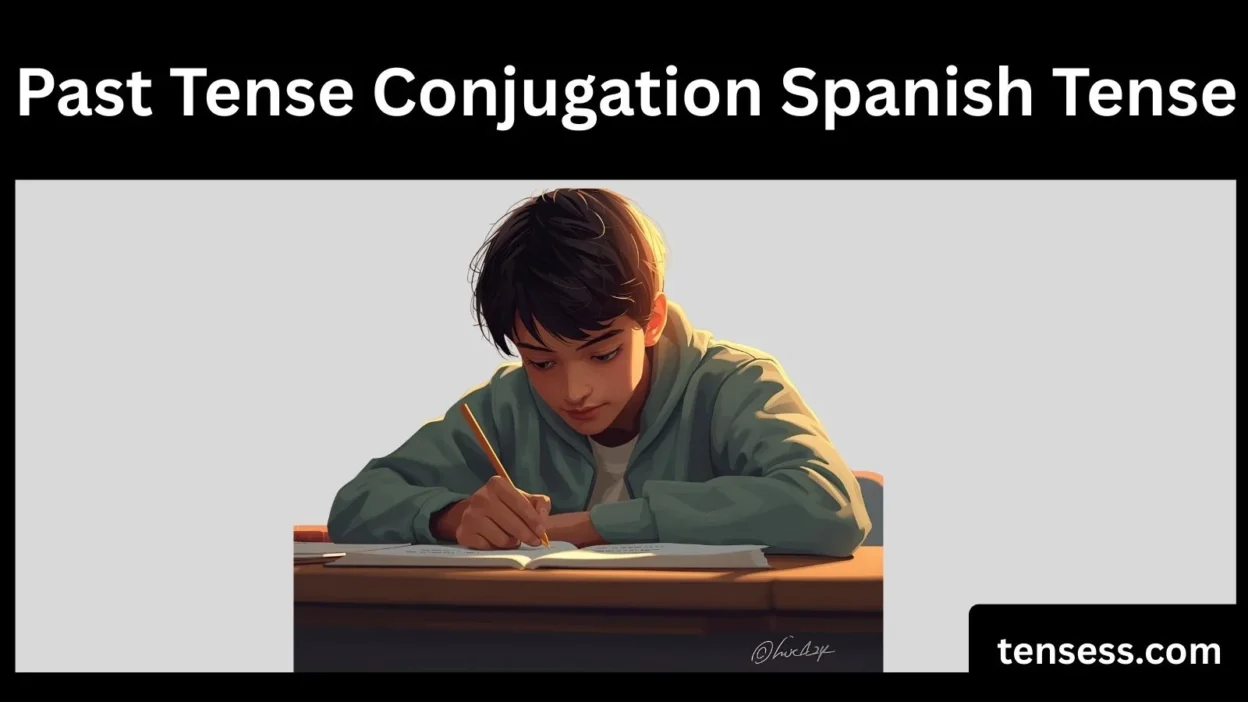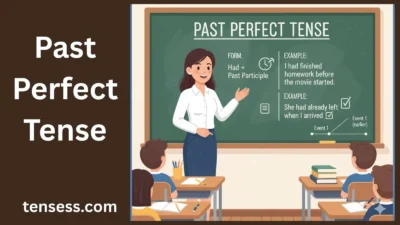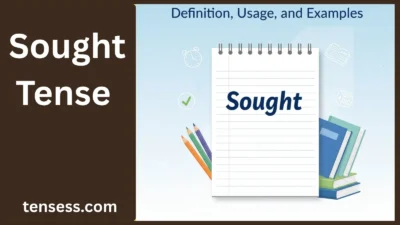Learning past tense conjugation in Spanish is a key step for students, language learners, writers, and grammar enthusiasts aiming to speak fluently.
Spanish has multiple past tenses, but the preterite and imperfect are the most commonly used.
These tenses help you describe actions that happened in the past, whether they were one-time events or ongoing situations.
This article breaks down the past tense in Spanish, focusing on the preterite and imperfect, with clear explanations, verb conjugation rules, and real-life examples.
Whether you’re a beginner or brushing up on grammar, this guide is designed to be skimmable, beginner-friendly, and packed with practical tips to help you master Spanish past tense conjugation.
Let’s dive into how to use these tenses correctly and confidently in everyday conversations!
What Is the Past Tense Conjugation in Spanish?
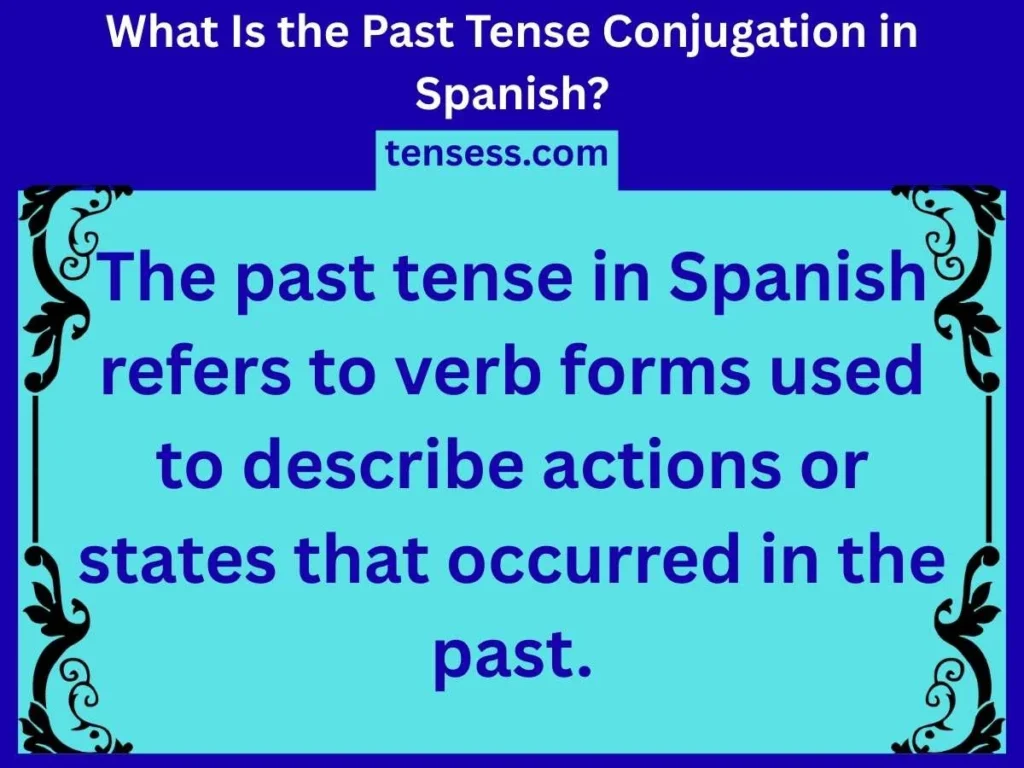
The two primary past tenses are:
- Preterite: Used for completed actions with a specific start and end (e.g., “I ate dinner”).
- Imperfect: Used for ongoing, habitual, or incomplete past actions (e.g., “I was eating dinner”).
Each tense has unique conjugation rules depending on the verb type (regular or irregular) and subject. Understanding when to use preterite vs. imperfect is crucial for clear communication.
How to Recognize the Past Tense in Spanish?
To identify the past tense in Spanish, look for specific verb endings or context clues:
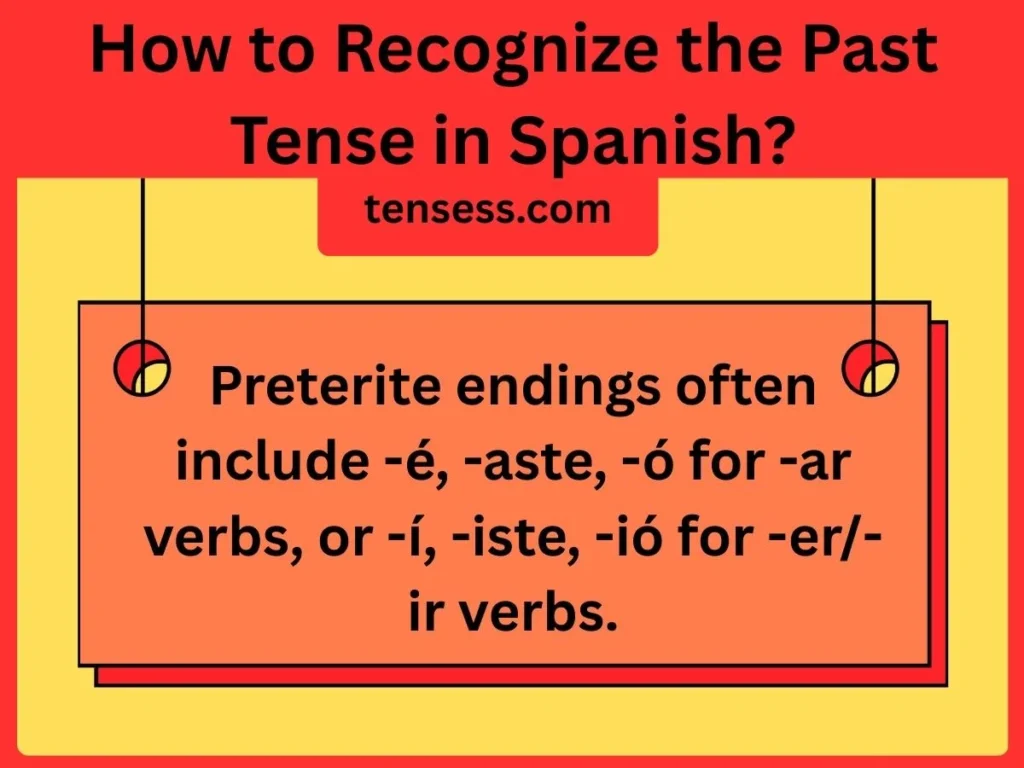
- Imperfect endings include -aba for -ar verbs or -ía for -er/-ir verbs.
- Context: Preterite describes one-time events; imperfect describes repeated or ongoing actions.
For example, “Corrí” (I ran, preterite) suggests a single event, while “Corría” (I was running, imperfect) implies a continuous or habitual action.
Structure of a Sentence in Past Tense
A typical sentence in the Spanish past tense follows this structure:
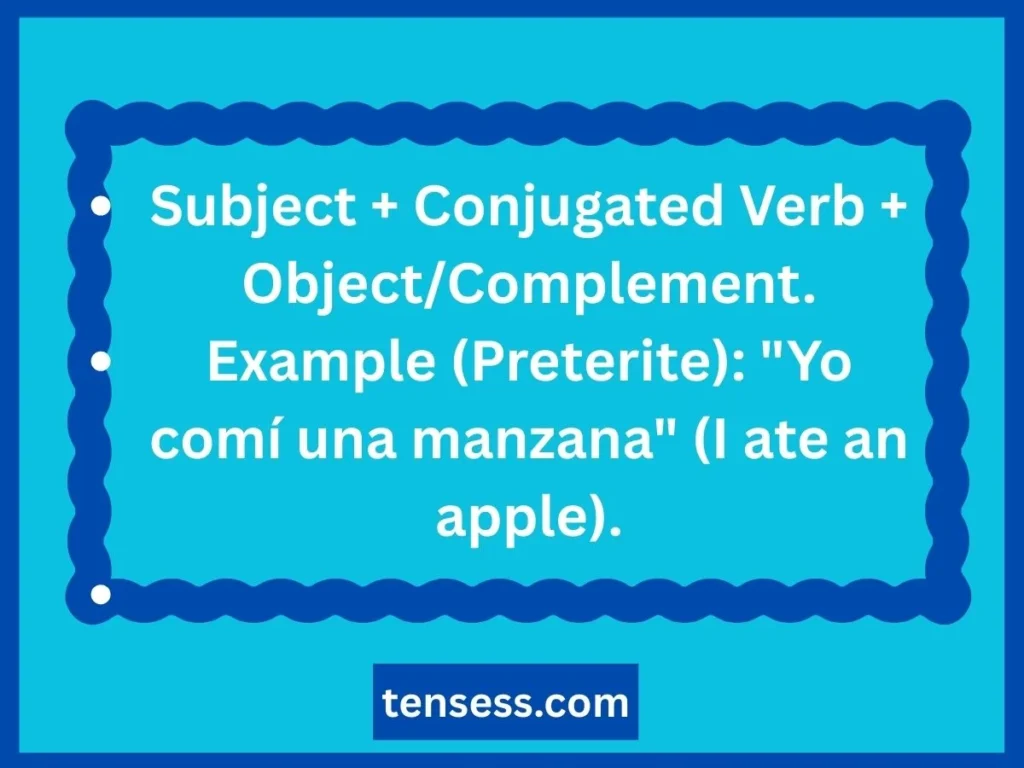
- Example (Imperfect): “Yo comía una manzana” (I was eating an apple).
The verb’s conjugation changes based on the subject and tense, while the sentence structure remains similar to English.
Formation of the Past Tense
Preterite Formation
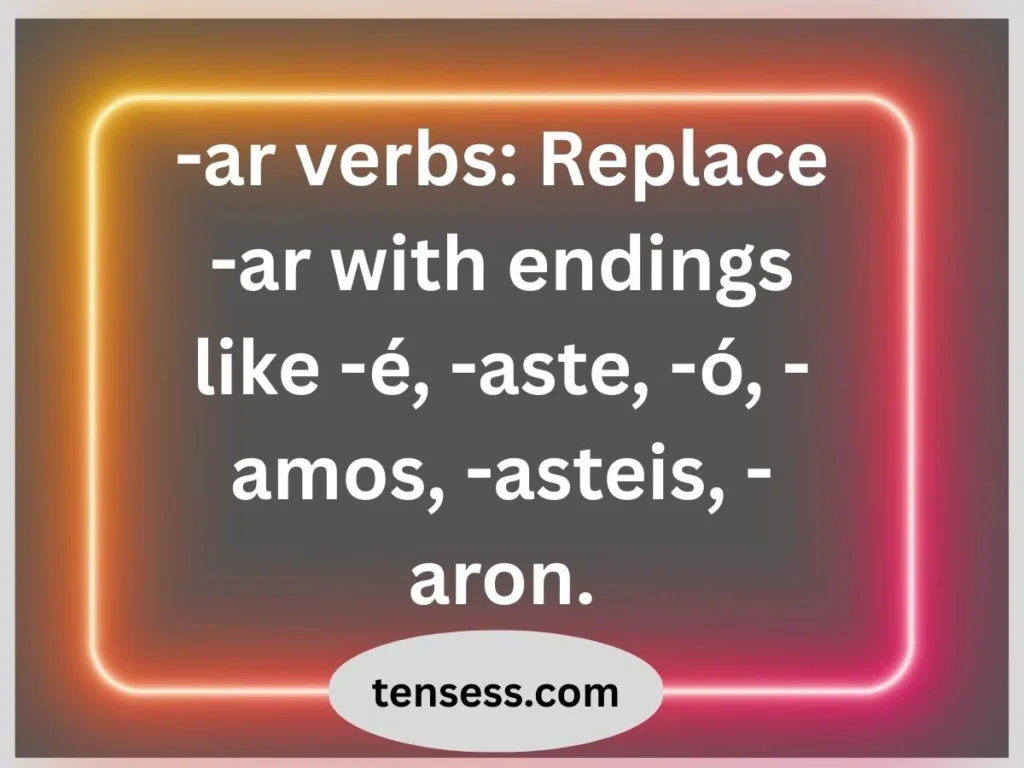
- Example: Hablar → hablé, hablaste, habló, etc.
- -er/-ir verbs: Replace -er/-ir with -í, -iste, -ió, -imos, -isteis, -ieron.
- Example: Comer → comí, comiste, comió, etc.
Imperfect Formation
- -ar verbs: Replace -ar with -aba, -abas, -aba, -ábamos, -abais, -aban.
- Example: Hablar → hablaba, hablabas, hablaba, etc.
- -er/-ir verbs: Replace -er/-ir with -ía, -ías, -ía, -íamos, -íais, -ían.
- Example: Vivir → vivía, vivías, vivía, etc.
Verbs in the Past Tense
Spanish verbs in the past tense fall into two categories:
- Regular verbs: Follow predictable conjugation patterns (e.g., hablar, comer, vivir).
- Irregular verbs: Have unique conjugations (e.g., ser, ir, tener).
Both preterite and imperfect tenses have regular and irregular forms, which we’ll explore further.
Helping Verbs in the Past Tense
Spanish past tenses don’t typically use helping verbs like English (e.g., “have” in “I have eaten”). However, compound tenses like the present perfect (e.g., “He comido” – I have eaten) use the helping verb haber. In this article, we focus on simple past tenses (preterite and imperfect), which don’t require helping verbs.
Explanation of Some Verbs in Past Tense Conjugation
- Hablar (to speak, regular -ar): Preterite (hablé – I spoke), Imperfect (hablaba – I was speaking).
- Comer (to eat, regular -er): Preterite (comí – I ate), Imperfect (comía – I was eating).
- Vivir (to live, regular -ir): Preterite (viví – I lived), Imperfect (vivía – I was living).
- Ser (to be, irregular): Preterite (fui – I was), Imperfect (era – I was).
- Ir (to go, irregular): Preterite (fui – I went), Imperfect (iba – I was going).
Each verb’s conjugation depends on the tense and subject.
Table of Some Regular and Irregular Verbs in Past Tense
| Verb | Preterite (Yo) | Imperfect (Yo) |
| Hablar | Hablé | Hablaba |
| Comer | Comí | Comía |
| Vivir | Viví | Vivía |
| Ser | Fui | Era |
| Ir | Fui | Iba |
| Tener | Tuve | Tenía |
| Hacer | Hice | Hacía |
| Venir | Vine | Venía |
Simple Sentence Examples
- Yo hablé con mi amigo ayer. (I spoke with my friend yesterday.)
- Nosotros comimos pizza anoche. (We ate pizza last night.)
- Ella vivió en México por un año. (She lived in Mexico for a year.)
- Tú fuiste al cine el sábado. (You went to the movies on Saturday.)
- Ellos tuvieron una fiesta grande. (They had a big party.)
- Él hizo su tarea rápido. (He did his homework quickly.)
- Vosotros vinisteis tarde a clase. (You all arrived late to class.)
- Yo canté en el concierto. (I sang at the concert.)
- Nosotros bailamos toda la noche. (We danced all night.)
- Ella escribió una carta. (She wrote a letter.)
Negative Sentence Examples
- Yo no hablé con mi amigo ayer. (I didn’t speak with my friend yesterday.)
- Nosotros no comimos pizza anoche. (We didn’t eat pizza last night.)
- Ella no vivió en México. (She didn’t live in Mexico.)
- Tú no fuiste al cine el sábado. (You didn’t go to the movies on Saturday.)
- Ellos no tuvieron una fiesta. (They didn’t have a party.)
- Él no hizo su tarea. (He didn’t do his homework.)
- Vosotros no vinisteis a clase. (You all didn’t come to class.)
- Yo no canté en el concierto. (I didn’t sing at the concert.)
- Nosotros no bailamos anoche. (We didn’t dance last night.)
- Ella no escribió una carta. (She didn’t write a letter.)
Interrogative Sentence Examples
- ¿Hablaste tú con mi amigo ayer? (Did you speak with my friend yesterday?)
- ¿Comieron ellos pizza anoche? (Did they eat pizza last night?)
- ¿Vivió ella en México? (Did she live in Mexico?)
- ¿Fuiste tú al cine el sábado? (Did you go to the movies on Saturday?)
- ¿Tuvieron ellos una fiesta? (Did they have a party?)
- ¿Hizo él su tarea? (Did he do his homework?)
- ¿Vinisteis vosotros a clase? (Did you all come to class?)
- ¿Canté yo en el concierto? (Did I sing at the concert?)
- ¿Bailaron ellos anoche? (Did they dance last night?)
- ¿Escribió ella una carta? (Did she write a letter?)
Negative and Interrogative Sentence Examples
- ¿No hablaste tú con mi amigo ayer? (Didn’t you speak with my friend yesterday?)
- ¿No comieron ellos pizza anoche? (Didn’t they eat pizza last night?)
- ¿No vivió ella en México? (Didn’t she live in Mexico?)
- ¿No fuiste tú al cine el sábado? (Didn’t you go to the movies on Saturday?)
- ¿No tuvieron ellos una fiesta? (Didn’t they have a party?)
- ¿No hizo él su tarea? (Didn’t he do his homework?)
- ¿No vinisteis vosotros a clase? (Didn’t you all come to class?)
- ¿No canté yo en el concierto? (Didn’t I sing at the concert?)
- ¿No bailaron ellos anoche? (Didn’t they dance last night?)
- ¿No escribió ella una carta? (Didn’t she write a letter?)
How to Conjugate Past Tense in Spanish
- Identify the verb type (-ar, -er, -ir).
- Determine if it’s regular or irregular.
- For regular verbs, use standard endings (see Formation section).
- For irregular verbs, memorize unique forms (e.g., ser: fui, fuiste, fue).
- Match the conjugation to the subject (yo, tú, él, etc.).
- Use preterite for completed actions.
- Use imperfect for ongoing or habitual actions.
- Check for stem changes in irregular verbs (e.g., tener → tuve).
- Practice with common verbs like hablar, comer, vivir.
- Use conjugation tables for reference.
Conjugation Table for Past Tense
Preterite (Hablar, Comer, Vivir)
| Subject | Hablar | Comer | Vivir |
| Yo | Hablé | Comí | Viví |
| Tú | Hablaste | Comiste | Viviste |
| Él/Ella | Habló | Comió | Vivió |
| Nosotros | Hablamos | Comimos | Vivimos |
| Vosotros | Hablasteis | Comisteis | Vivisteis |
| Ellos | Hablaron | Comieron | Vivieron |
Imperfect (Hablar, Comer, Vivir)
| Subject | Hablar | Comer | Vivir |
| Yo | Hablaba | Comía | Vivía |
| Tú | Hablabas | Comías | Vivías |
| Él/Ella | Hablaba | Comía | Vivía |
| Nosotros | Hablábamos | Comíamos | Vivíamos |
| Vosotros | Hablabaís | Comíais | Vivíais |
| Ellos | Hablaban | Comían | Vivían |
Spelling Changes or Irregularities
- Stem-changing verbs: Some -ir verbs (e.g., dormir → durmió in preterite) change stems.
- Irregular preterite verbs: Verbs like ser, ir, tener have unique forms (e.g., fui, tuve).
- Spelling changes: Verbs ending in -car (e.g., buscar → busqué) or -gar (e.g., jugar → jugué) change to maintain pronunciation.
- Imperfect irregularities: Only ser (era), ir (iba), and ver (veía) are irregular.
10–15 Sentence Examples with Different Subjects
- Yo hablé con mi profesor ayer. (I spoke with my teacher yesterday.)
- Tú comiste en un restaurante caro. (You ate at an expensive restaurant.)
- Él vivió en España por dos años. (He lived in Spain for two years.)
- Nosotros fuimos al parque. (We went to the park.)
- Ellos tuvieron una reunión importante. (They had an important meeting.)
- Ella hizo un pastel delicioso. (She made a delicious cake.)
- Vosotros cantasteis en la fiesta. (You all sang at the party.)
- Yo corría todas las mañanas. (I was running every morning.)
- Tú vivías cerca de la playa. (You were living near the beach.)
- Nosotros comíamos juntos cada día. (We were eating together every day.)
- Él era muy amable. (He was very kind.)
- Ellos iban a la escuela a pie. (They were going to school on foot.)
- Ella tenía un perro pequeño. (She had a small dog.)
- Vosotros veíais televisión todas las noches. (You all were watching TV every night.)
- Yo vine a la ciudad ayer. (I came to the city yesterday.)
Common Mistakes with Past Tense Conjugation
- Confusing preterite and imperfect (e.g., using hablé instead of hablaba for ongoing actions).
- Forgetting irregular conjugations (e.g., saying tení instead of tuve).
- Incorrect subject-verb agreement (e.g., yo habló instead of yo hablé).
- Misusing stem changes (e.g., dormí instead of durmió).
- Overusing preterite for habitual actions (e.g., comí instead of comía for “I was eating”).
- Ignoring spelling changes (e.g., buscé instead of busqué).
- Mixing tenses in a sentence (e.g., hablé y comía inconsistently).
- Forgetting accents on conjugated verbs (e.g., hable instead of hablé).
- Using English sentence structure (e.g., adding unnecessary helping verbs).
- Not practicing irregular verbs enough, leading to errors like fue instead of era.
How to Avoid Common Mistakes
- Study preterite vs. imperfect triggers (e.g., “yesterday” for preterite, “always” for imperfect).
- Memorize irregular verb forms using flashcards.
- Double-check subject-verb agreement in conjugations.
- Practice stem-changing verbs separately.
- Read sentences aloud to catch incorrect tense usage.
- Use mnemonic devices for spelling changes (e.g., -car → -qué).
- Write practice sentences mixing both tenses.
- Use a grammar checker to spot accent errors.
- Translate English sentences to Spanish to practice structure.
- Review mistakes in quizzes or exercises regularly.
Related Verbs and Synonyms for Past Tense
- Ser (to be) vs. Estar (to be): Both used in past tense but differ in meaning (e.g., era for permanent states, estaba for temporary states).
- Ir (to go) vs. Venir (to come): Often confused due to similar irregular forms (e.g., fui for both).
- Tener (to have) vs. Poseer (to possess): Tener is more common in past tense.
- Hacer (to do/make) vs. Realizar (to carry out): Hacer is more versatile.
- Comer vs. Almorzar (to eat lunch): Context-specific synonyms.
Sentence Comparisons
- Ser: Yo era estudiante. (I was a student, permanent.) vs. Yo estaba cansado. (I was tired, temporary.)
- Ir: Nosotros fuimos al mercado. (We went to the market.) vs. Nosotros vinimos a casa. (We came home.)
Tips to Practice Using Past Tense in Spanish
- Write a daily journal using preterite and imperfect.
- Narrate past events in Spanish to a friend.
- Watch Spanish movies and note past tense usage.
- Use apps like Duolingo for conjugation drills.
- Create flashcards for irregular verbs.
- Practice with a language partner using past tense prompts.
- Read Spanish short stories and highlight past tense verbs.
- Record yourself speaking and review for errors.
- Join online forums to discuss past experiences in Spanish.
- Take quizzes to test your conjugation skills.
Frequently Asked Questions
- What’s the difference between preterite and imperfect?
Preterite is for completed actions; imperfect is for ongoing or habitual actions. - Are there irregular verbs in the imperfect?
Only ser, ir, and ver are irregular. - How do I know which past tense to use?
Use context clues like time expressions (e.g., “yesterday” for preterite). - Do all verbs follow the same conjugation rules?
No, irregular verbs have unique forms. - Can haber be used in simple past tense?
No, it’s used in compound tenses like present perfect. - How do I conjugate stem-changing verbs?
Stem changes apply in preterite for some -ir verbs. - What are common time expressions for preterite?
Ayer, anoche, la semana pasada. - What are common time expressions for imperfect?
Siempre, todos los días, a menudo. - Why do some verbs have spelling changes?
To maintain pronunciation (e.g., -car → -qué). - How can I practice past tense conjugation?
Use exercises, quizzes, and real-life conversations.
Exercises
- Conjugate hablar in preterite for all subjects.
- Write 5 sentences using comer in imperfect.
- Translate: “I was singing yesterday” into Spanish.
- Identify the tense: “Ella vivía en París.”
- Correct the error: “Yo comí todos los días.”
- Conjugate ser in both preterite and imperfect.
- Write a paragraph about your last vacation using preterite.
- Describe your childhood using imperfect.
- Fill in the blank: “Nosotros ___ (ir) al cine anoche.”
- Create a dialogue using both past tenses.
Quizzes
- What is the preterite form of vivir for “tú”?
a) Vivías b) Viviste c) Vivió
Answer: b) Viviste - Which tense is used for habitual actions?
a) Preterite b) Imperfect
Answer: b) Imperfect - What is the imperfect form of comer for “ellos”?
a) Comían b) Comieron c) Comí
Answer: a) Comían - True or False: Ser is regular in preterite.
Answer: False - Fill in: Yo ___ (tener) un examen ayer.
Answer: Tuve - Which verb is irregular in imperfect?
a) Hablar b) Ver c) Comer
Answer: b) Ver - Translate: “We were dancing.”
Answer: Bailábamos - What’s the preterite of ir for “yo”?
a) Iba b) Fui c) Era
Answer: b) Fui - Correct the error: “Ella cantó todos los días.”
Answer: Ella cantaba todos los días. - Which tense for: “I ate at 7 p.m.”?
Answer: Preterite
True or False
- The preterite is used for ongoing past actions. False
- The imperfect has only three irregular verbs. True
- Hablar is irregular in preterite. False
- Fui can mean “I was” or “I went.” True
- The imperfect uses -é endings for -ar verbs. False
- Tener is irregular in preterite. True
- You need haber for simple past tenses. False
- Stem changes occur in imperfect for -ar verbs. False
- “Ayer” signals the preterite tense. True
- All -ir verbs are regular in preterite. False
Conclusion
Mastering past tense conjugation in Spanish is essential for describing past events clearly and accurately.
By understanding the preterite and imperfect tenses, you can express completed actions or ongoing situations with confidence.
This guide has provided you with the tools—conjugation rules, examples, and practice tips—to use these tenses effectively.
Whether you’re a student, language learner, or grammar enthusiast, practicing with real-life sentences and quizzes will solidify your skills.
Try writing a short story or journal entry using both tenses, and consider using a grammar checker to refine your work.
Keep practicing, and soon Spanish past tense conjugation will feel natural! Share your progress in the comments or try our exercises to test your knowledge.
